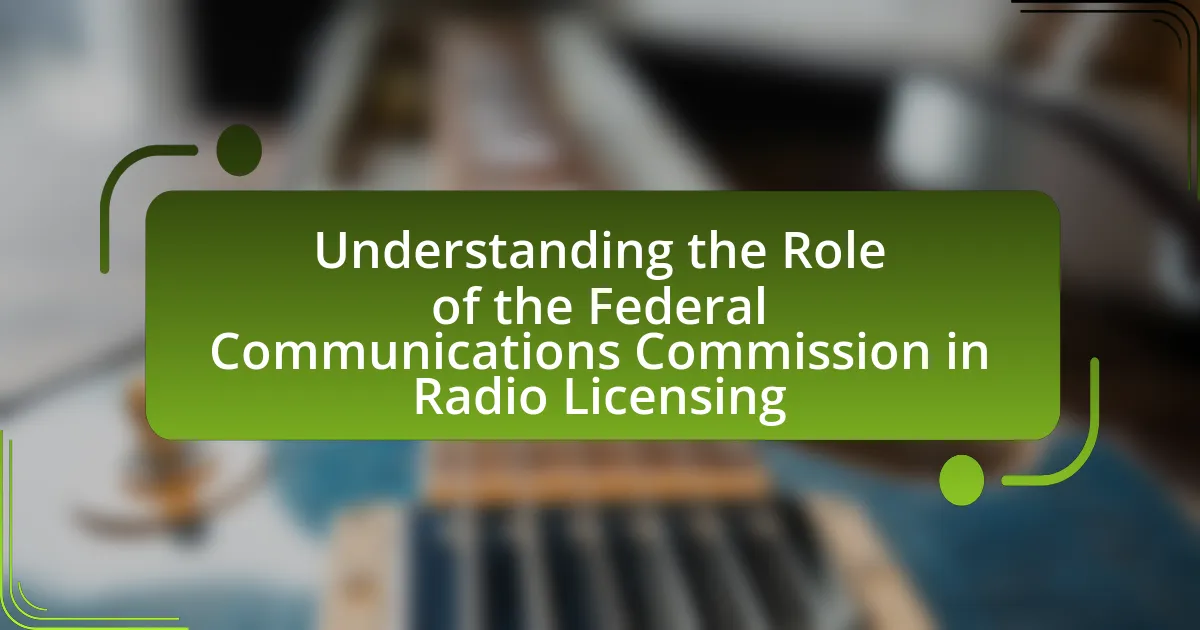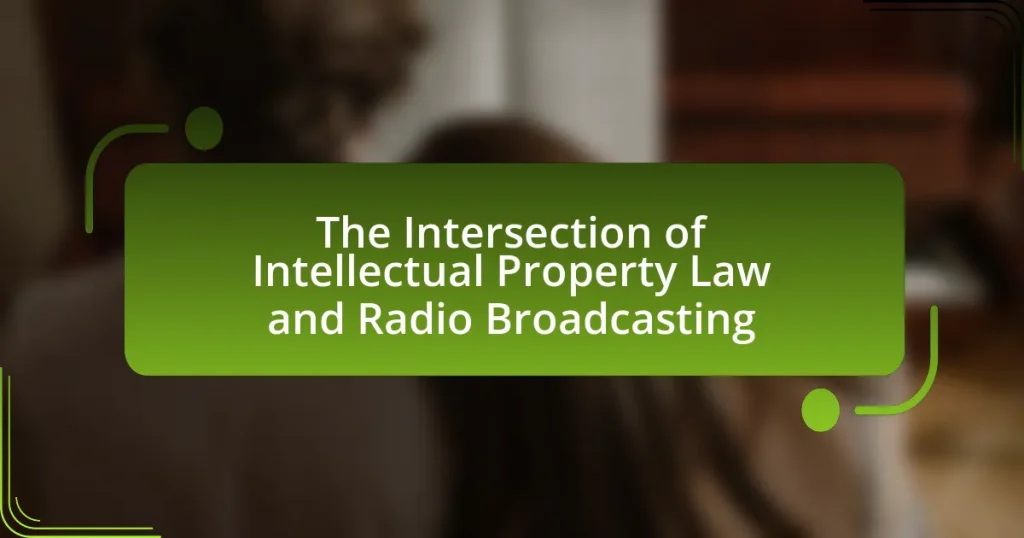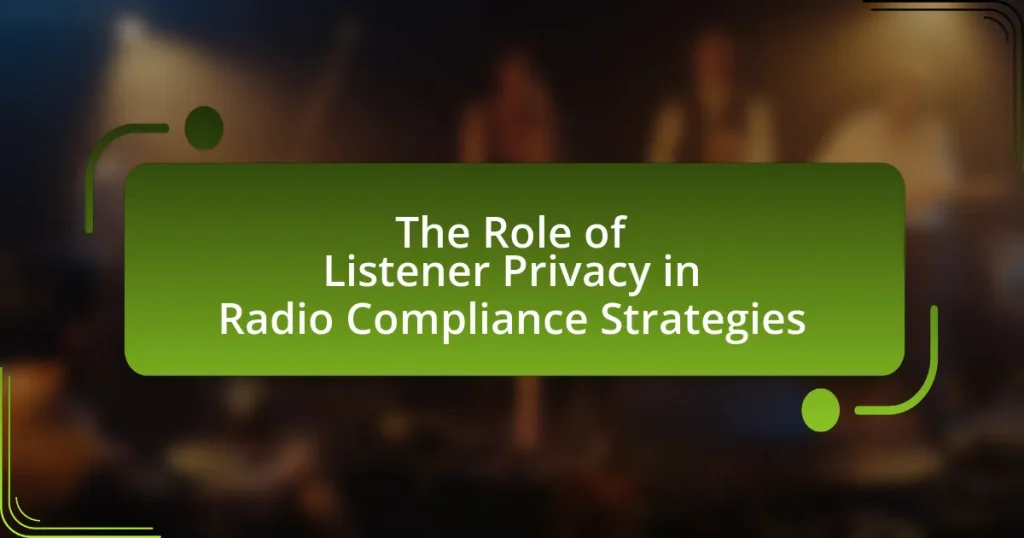The Federal Communications Commission (FCC) is an independent agency of the U.S. government that regulates communications by radio, television, wire, satellite, and cable. This article provides a comprehensive overview of the FCC’s role in radio licensing, including its establishment, mission, and primary functions. It discusses the processes for issuing radio licenses, the importance of licensing for communication and public safety, and the impact on competition within the broadcasting industry. Additionally, the article addresses the challenges the FCC faces in adapting to technological changes and engaging with stakeholders, while outlining best practices for applicants seeking radio licenses.
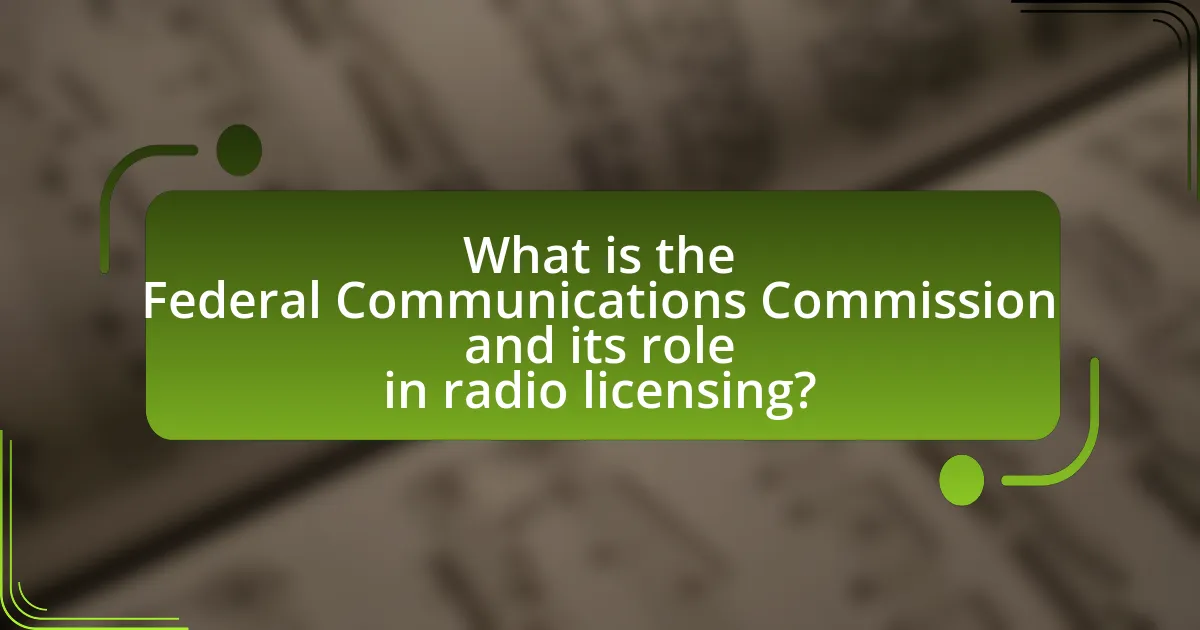
What is the Federal Communications Commission and its role in radio licensing?
The Federal Communications Commission (FCC) is an independent agency of the United States government responsible for regulating interstate and international communications by radio, television, wire, satellite, and cable. Its role in radio licensing involves issuing licenses to radio stations, ensuring compliance with federal regulations, and managing the radio frequency spectrum to prevent interference between different broadcasting entities. The FCC’s authority is established under the Communications Act of 1934, which mandates that the agency promote the public interest, convenience, and necessity in communications.
How was the Federal Communications Commission established?
The Federal Communications Commission (FCC) was established by the Communications Act of 1934. This act aimed to consolidate federal regulation of telephone, telegraph, and radio communications under one agency, replacing the Federal Radio Commission. The establishment of the FCC was a response to the growing complexity of communication technologies and the need for a regulatory body to manage the increasing demand for radio frequencies and ensure fair competition in the telecommunications industry.
What were the key events leading to the formation of the FCC?
The key events leading to the formation of the Federal Communications Commission (FCC) include the Radio Act of 1927 and the Communications Act of 1934. The Radio Act established the Federal Radio Commission (FRC) to regulate radio broadcasting and address issues of interference among stations. This act was a response to the chaotic state of radio communications in the 1920s, where unregulated broadcasting led to signal interference and confusion. The FRC’s limited authority and the growing complexity of communication technologies prompted the need for a more comprehensive regulatory body. Consequently, the Communications Act of 1934 replaced the FRC with the FCC, granting it broader powers to regulate all forms of communication, including radio, television, and telephony, thereby establishing a framework for modern communications regulation.
What is the FCC’s mission and vision?
The Federal Communications Commission’s (FCC) mission is to regulate interstate and international communications by radio, television, wire, satellite, and cable. Its vision is to ensure that all Americans have access to robust and affordable communications services. The FCC aims to promote competition, innovation, and investment in broadband services, while also protecting consumers and ensuring public safety. This mission and vision are grounded in the Communications Act of 1934, which established the FCC to serve the public interest in communication services.
What are the primary functions of the FCC in radio licensing?
The primary functions of the FCC in radio licensing include managing the allocation of radio frequencies, issuing licenses to broadcasters, and enforcing regulations to ensure compliance with communication laws. The FCC oversees the licensing process to prevent interference between different radio services and to promote efficient use of the electromagnetic spectrum. Additionally, the FCC establishes technical standards and policies that broadcasters must adhere to, ensuring that public interest is served and that communication services are accessible to all.
How does the FCC regulate radio frequencies?
The Federal Communications Commission (FCC) regulates radio frequencies by allocating spectrum bands, issuing licenses, and enforcing compliance with regulations. The FCC manages the electromagnetic spectrum to ensure efficient use and to minimize interference among different radio services. For instance, the FCC conducts auctions for spectrum licenses, which allows entities to bid for the right to use specific frequency bands, thereby promoting competition and innovation in telecommunications. Additionally, the FCC establishes technical standards and operational rules that licensees must follow, ensuring that radio communications operate effectively and without harmful interference.
What processes does the FCC use for issuing radio licenses?
The Federal Communications Commission (FCC) issues radio licenses through a structured application and review process. This process begins with the submission of an application by the entity seeking a license, which must include detailed information about the proposed station, including technical specifications and operational plans. The FCC then conducts a thorough review to ensure compliance with regulatory requirements, including frequency availability and interference considerations.
Once the application is deemed complete, it is placed in a public notice for a specified period, allowing for public comment and potential objections. After considering any feedback, the FCC may grant the license, impose conditions, or deny the application based on its findings. This process is governed by the Communications Act of 1934 and subsequent regulations, ensuring that the allocation of radio frequencies serves the public interest.
Why is radio licensing important for communication?
Radio licensing is important for communication because it regulates the use of radio frequencies to prevent interference between different communication services. The Federal Communications Commission (FCC) issues licenses to ensure that radio spectrum is allocated efficiently and that operators comply with technical standards. This regulation is crucial for maintaining clear and reliable communication channels, as evidenced by the fact that unlicensed use can lead to signal overlap, which disrupts essential services such as emergency communications and broadcasting.
What impact does radio licensing have on public safety?
Radio licensing significantly enhances public safety by regulating the use of radio frequencies to prevent interference among emergency services. The Federal Communications Commission (FCC) issues licenses that ensure only authorized entities, such as police, fire, and medical services, can operate on specific frequencies. This regulation is crucial because it allows for clear communication during emergencies, which can save lives. For instance, the FCC’s licensing framework has been instrumental in maintaining the integrity of communication channels used by first responders, thereby facilitating timely and effective responses to crises.
How does radio licensing affect competition in the broadcasting industry?
Radio licensing significantly affects competition in the broadcasting industry by regulating the number of available frequencies and ensuring that licenses are distributed fairly among broadcasters. The Federal Communications Commission (FCC) allocates licenses through a competitive bidding process, which can limit the entry of new players into the market. For instance, in 2020, the FCC auctioned off 3,000 new radio licenses, demonstrating how licensing can create barriers for new entrants while benefiting established broadcasters who already hold licenses. This regulatory framework can lead to market concentration, where a few companies dominate the airwaves, ultimately reducing diversity in programming and limiting consumer choice.
How does the FCC ensure compliance with radio licensing regulations?
The FCC ensures compliance with radio licensing regulations through a combination of monitoring, enforcement actions, and public reporting. The agency conducts regular inspections and audits of licensed radio stations to verify adherence to technical and operational standards. Additionally, the FCC investigates complaints from the public and other entities regarding potential violations, which can lead to enforcement actions such as fines or license revocation. The agency also maintains a publicly accessible database of licensed stations, allowing for transparency and accountability in the licensing process. This systematic approach helps maintain order in the radio spectrum and ensures that operators comply with established regulations.
What challenges does the FCC face in radio licensing?
The Federal Communications Commission (FCC) faces several challenges in radio licensing, including spectrum scarcity, interference management, and regulatory compliance. Spectrum scarcity arises from the increasing demand for radio frequencies due to technological advancements and the proliferation of wireless devices, making it difficult for the FCC to allocate frequencies efficiently. Interference management is another significant challenge, as overlapping signals can disrupt communication, necessitating careful monitoring and coordination among licensees. Additionally, ensuring compliance with regulations and addressing violations can strain the FCC’s resources, as the agency must balance enforcement with the need to foster innovation and competition in the broadcasting sector.

What are the types of radio licenses issued by the FCC?
The Federal Communications Commission (FCC) issues several types of radio licenses, including Commercial Radio Operator Licenses, Amateur Radio Licenses, Broadcast Radio Licenses, and Experimental Radio Licenses. Commercial Radio Operator Licenses are required for individuals operating certain types of radio equipment in commercial settings. Amateur Radio Licenses are granted to individuals for personal, non-commercial use of radio frequencies. Broadcast Radio Licenses are issued to radio stations for transmitting programming to the public, while Experimental Radio Licenses allow for testing and experimentation with new technologies. Each license type serves a specific purpose and is governed by regulations set forth by the FCC.
What are the differences between commercial and non-commercial radio licenses?
Commercial radio licenses are issued to stations that operate for profit, while non-commercial radio licenses are granted to stations that do not operate for profit and typically focus on educational, cultural, or community-oriented programming. The Federal Communications Commission (FCC) regulates these licenses, requiring commercial stations to generate revenue through advertising, whereas non-commercial stations rely on donations, grants, and sponsorships. Additionally, commercial stations must adhere to stricter regulations regarding advertising content and hours, while non-commercial stations are often exempt from such requirements, allowing them to focus on their mission-driven content.
How do the requirements for commercial radio licenses differ from non-commercial ones?
Commercial radio licenses require applicants to demonstrate financial viability and a profit-oriented business model, while non-commercial licenses focus on educational or community service objectives without the expectation of profit. The Federal Communications Commission (FCC) mandates that commercial stations provide evidence of funding sources and operational plans to ensure profitability, whereas non-commercial stations must show how they will serve the public interest, often through educational programming or community engagement. This distinction is rooted in the Communications Act of 1934, which established different regulatory frameworks for commercial and non-commercial entities to promote diverse broadcasting services.
What are the benefits of obtaining a non-commercial radio license?
Obtaining a non-commercial radio license provides several benefits, including access to a dedicated broadcasting frequency, eligibility for funding and grants, and the ability to serve community interests without the pressure of profit. Non-commercial radio stations can operate with lower operational costs due to exemptions from certain fees and regulations that apply to commercial stations. Additionally, these licenses allow for the promotion of educational, cultural, and public service programming, which can enhance community engagement and support local voices. The Federal Communications Commission (FCC) facilitates this process, ensuring that non-commercial stations contribute to the diversity of media and provide valuable content to underserved audiences.
What is the process for applying for a radio license?
The process for applying for a radio license involves submitting an application to the Federal Communications Commission (FCC). Applicants must complete the appropriate forms, such as Form 601 for commercial radio services or Form 314 for broadcast stations, and provide necessary documentation, including technical specifications and proof of eligibility. The FCC reviews the application for compliance with regulations, evaluates potential interference with existing services, and may require public notice or comment periods. Once approved, the applicant receives a license that specifies operational parameters. This process ensures that radio frequencies are allocated efficiently and without interference, adhering to the Communications Act of 1934 and subsequent regulations.
What documentation is required for a radio license application?
A radio license application requires several key documents, including a completed application form, proof of citizenship or residency, and technical specifications of the proposed radio equipment. Additionally, applicants must provide an environmental assessment if applicable, and any necessary fees must be submitted. These requirements ensure compliance with the Federal Communications Commission’s regulations, which govern the licensing process to maintain orderly use of the radio spectrum.
How long does the radio licensing process typically take?
The radio licensing process typically takes between three to six months. This duration can vary based on factors such as the complexity of the application, the volume of applications being processed by the Federal Communications Commission (FCC), and any potential issues that may arise during the review. The FCC’s established timelines indicate that straightforward applications may be processed more quickly, while those requiring additional scrutiny or public comment can extend the timeline.
What are the common reasons for radio license denial?
Common reasons for radio license denial include failure to meet technical requirements, lack of financial qualifications, and issues with character qualifications. The Federal Communications Commission (FCC) requires applicants to demonstrate compliance with specific technical standards, such as signal strength and interference limits; failure to do so can result in denial. Additionally, applicants must show they have the financial resources to operate the station, and insufficient funding can lead to rejection. Character qualifications involve background checks, and any history of violations or criminal activity can disqualify an applicant. These criteria are established to ensure that radio operations are conducted responsibly and in the public interest.
How can applicants address issues that lead to license denial?
Applicants can address issues that lead to license denial by thoroughly reviewing the reasons for denial and taking corrective actions. For instance, if the denial is due to incomplete documentation, applicants should ensure that all required forms and supporting materials are submitted accurately and on time. If the denial stems from a failure to meet technical standards, applicants must rectify any deficiencies in their technical proposals or equipment specifications. Additionally, engaging with the Federal Communications Commission (FCC) through consultations or seeking legal advice can provide clarity on specific issues and help applicants navigate the reapplication process effectively.
What recourse do applicants have if their license is denied?
Applicants whose license is denied by the Federal Communications Commission (FCC) can file a petition for reconsideration or an application for review. A petition for reconsideration must be submitted within 30 days of the denial and allows the applicant to request the FCC to re-evaluate its decision based on new evidence or arguments. If the petition is denied, applicants can escalate the matter by filing an application for review with the full Commission, which must also be filed within 30 days of the petition’s denial. This process is outlined in the FCC’s rules, specifically under 47 CFR § 1.106 and § 1.115, providing a structured recourse for applicants seeking to challenge a denial.
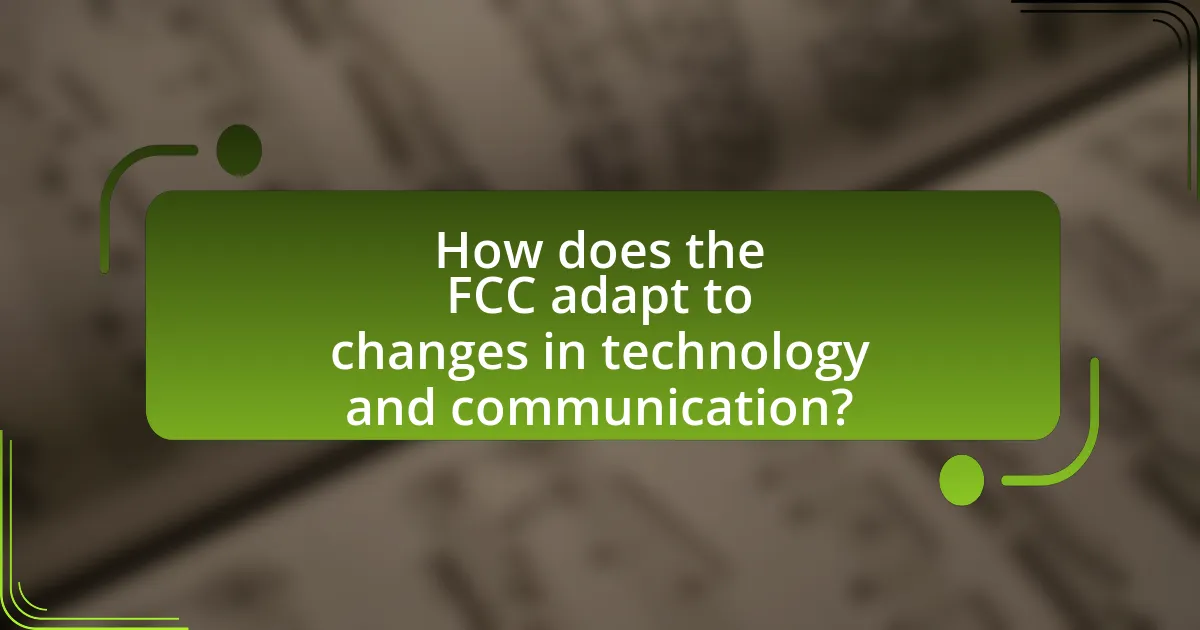
How does the FCC adapt to changes in technology and communication?
The FCC adapts to changes in technology and communication by implementing regulatory frameworks that accommodate new innovations while ensuring public interest. For instance, the FCC has established policies for spectrum allocation to support emerging technologies like 5G, which enhances mobile broadband services. Additionally, the agency conducts regular reviews of its regulations to ensure they remain relevant in the face of rapid technological advancements, such as the transition from analog to digital broadcasting. This proactive approach is evidenced by initiatives like the 2010 National Broadband Plan, which aimed to expand broadband access and improve infrastructure in response to the growing demand for high-speed internet.
What role does the FCC play in the transition to digital broadcasting?
The Federal Communications Commission (FCC) oversees the transition to digital broadcasting by establishing regulations, timelines, and technical standards for the conversion from analog to digital signals. The FCC mandated the digital television transition, which culminated in the analog broadcast shutdown on June 12, 2009, ensuring that broadcasters switched to digital transmission to improve picture quality and free up spectrum for other uses. This regulatory framework facilitated the allocation of frequencies for digital broadcasting and provided consumer education initiatives to assist viewers in adapting to the new technology.
How has the FCC updated its regulations to accommodate new technologies?
The FCC has updated its regulations to accommodate new technologies by implementing policies that promote innovation and streamline processes for emerging communication services. For instance, the introduction of the 5G Fast Plan in 2018 aimed to accelerate the deployment of 5G networks by reducing regulatory barriers and expediting the approval process for infrastructure. Additionally, the FCC has adopted rules for unlicensed spectrum use, allowing technologies like Wi-Fi to flourish, which supports a wide range of applications and devices. These updates reflect the FCC’s commitment to adapting its regulatory framework to foster technological advancements and enhance competition in the telecommunications sector.
What challenges does the FCC face with emerging communication technologies?
The FCC faces significant challenges with emerging communication technologies, primarily related to regulatory adaptation, spectrum allocation, and cybersecurity. As new technologies like 5G and the Internet of Things (IoT) evolve, the FCC must update its regulatory frameworks to ensure they are effective and relevant. For instance, the rapid deployment of 5G networks requires efficient spectrum management to prevent interference and ensure quality service, which is complicated by the increasing demand for bandwidth. Additionally, cybersecurity threats associated with these technologies pose risks to national security and consumer privacy, necessitating robust regulatory measures. The FCC’s ability to address these challenges is critical for fostering innovation while protecting public interests.
How does the FCC engage with stakeholders in the radio industry?
The FCC engages with stakeholders in the radio industry through public meetings, rulemaking processes, and stakeholder outreach initiatives. These engagements allow the FCC to gather input from various parties, including broadcasters, industry associations, and the public, ensuring that diverse perspectives are considered in regulatory decisions. For example, the FCC holds open meetings where stakeholders can present their views on proposed regulations, and it also issues notices of proposed rulemaking to solicit comments from the industry. This structured approach facilitates transparency and collaboration, ultimately shaping policies that affect the radio landscape.
What methods does the FCC use to gather public input on radio licensing issues?
The FCC gathers public input on radio licensing issues primarily through public notices, comment periods, and open meetings. Public notices are issued to announce proposed rule changes or licensing actions, allowing stakeholders to submit comments. The FCC also holds comment periods where individuals and organizations can provide feedback on specific issues, ensuring diverse perspectives are considered. Additionally, open meetings provide a platform for public participation, where stakeholders can express their views directly to FCC commissioners. These methods facilitate transparency and community engagement in the radio licensing process.
How does the FCC collaborate with other government agencies regarding radio licensing?
The FCC collaborates with other government agencies regarding radio licensing through inter-agency coordination and information sharing. This collaboration often involves agencies such as the National Oceanic and Atmospheric Administration (NOAA) for spectrum management related to weather services and the Department of Defense (DoD) for military communications. The FCC also engages in joint initiatives to ensure compliance with regulations and to address interference issues, which is critical for maintaining the integrity of radio communications. For instance, the FCC’s coordination with the National Telecommunications and Information Administration (NTIA) is essential for managing federal spectrum use and resolving conflicts between federal and non-federal users.
What best practices should applicants follow when seeking a radio license?
Applicants seeking a radio license should thoroughly research the Federal Communications Commission (FCC) regulations and guidelines. Understanding the specific requirements for the type of radio service desired, such as AM, FM, or digital broadcasting, is crucial. Applicants must prepare a detailed application that includes technical specifications, proposed coverage area, and compliance with local zoning laws. Additionally, engaging with the community to assess interest and support for the proposed station can strengthen the application.
Proof of the importance of these practices can be found in the FCC’s own guidelines, which emphasize the need for applicants to demonstrate technical proficiency and community engagement to ensure successful licensing. Following these best practices increases the likelihood of approval and helps applicants navigate the complex licensing process effectively.
